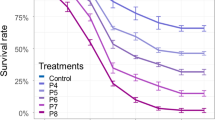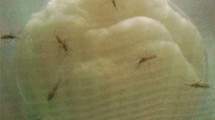Abstract
The gut bacteria of insects are associated with digestion, nutrition, and reproduction. The midgut bacteria of Anopheles mosquitoes have been examined predominantly for their effects on the transmission of Plasmodium parasites. However, the effects of midgut bacteria on Anopheles mosquitoes have not been studied. In this study, we investigated the effects of midgut bacteria on adult female An. stephensi mosquitoes. These mosquitoes were fed antibiotics mixed with 10% sucrose for 2 weeks to alter the composition of their midgut bacteria. The results showed that the mosquitoes fed with streptomycin (ST) or kanamycin (KM) showed inhibited egg maturation 2 days after blood feeding. Methylobacterium sp. was the predominant bacterium in the midgut of mosquitoes fed KM or ST for 2 weeks (ST/2 weeks). Mosquitoes that were fed suspensions of Methylobacterium sp. isolated from the midgut of ST/2 weeks after blood feeding for 3 days showed inhibited egg maturation. Furthermore, egg maturation was inhibited in mosquitoes that were fed supernatant and precipitate obtained by boiling and centrifuging Methylobacterium sp. suspension. Thus, this study demonstrated that Methylobacterium sp. isolated from the midgut of An. stephensi mosquitoes after blood feeding inhibited egg maturation.






Similar content being viewed by others
Data availability
Data are contained within the article.
References
Ant TH, Herd CS, Geoghegan V, Hoffmann AA, Sinkins SP (2018) The Wolbachia strain wAu provides highly efficient virus transmission blocking in Aedes aegypti. PLOS Pathog 14:e1006815
Bai H, Gelman DB, Palli SR (2010) Mode of action of Methoprene in affecting female reproduction in the African malaria mosquito. Anopheles Gambiae Pest Manag Sci 66:936–943
Bando H, Okado K, Guelbeogo WM, Badolo A, Aonuma H, Nelson B, Fukumoto S, Xuan X, Sagnon N, Kanuka H (2013) Intra–specific diversity of Serratia marcescens in Anopheles mosquito midgut defines Plasmodium transmission capacity. Sci Rep 3:1641
Billingsley PF, Hecker H (1991) Blood digestion in the mosquito, Anopheles stephensi Liston (Diptera: Culicidae): activity and distribution of trypsin, aminopeptidase, and alpha–glucosidase in the midgut. J Med Entomol 28:865–871
Breznak JA (2000) Ecology of prokaryotic microbes in the guts of wood and litter-feeding termites. In: Abe T, Bignell DE, Higashi M, (ed) Termites: evolution, sociality, symbioses, ecology. Kluwer Academic Publishers, Dordrecht. pp. 209–232
Brown MR, Cao C (2001) Distribution of ovary ecdysteroidogenic hormone I in the nervous system and gut of mosquitoes. J Insect Sci 1:3
Christophers SR (1911) The development of the egg follicle in anophelines. Paludisme 2:73–88
Cirimotich CM, Dong Y, Garver LS, Sim S, Dimopoulos G (2010) Mosquito immune defenses against Plasmodium infection. Dev Comp Immunol 34:387–395
Clement AN (1992) The biology of mosquitoes. In: Development, nutrition and reproduction. Chapman and hall, New York. pp 26–45
Dennison NJ, Saraiva RG, Cirimotich CM, Mlambo G, Mongodin EF, Dimopoulos G (2016) Functional genomic analyses of Enterobacter, Anopheles and Plasmodium reciprocal interactions that impact vector competence. Malar J 15:425
Dong Y, Manfredini F, Dimopoulos G (2009) Implication of the mosquito midgut microbiota in the defense against malaria parasites. PLOS Pathog 5:e1000423
Ezemuoka LC, Akorli EA, Aboagye-Antwi F, Akorli J (2020) Mosquito midgut Enterobacter cloacae and Serratia marcescens affect the fitness of adult female Anopheles gambiae sl. PLoS ONE 15:e0238931
Furuhata K, Kato Y, Goto K, Hara M, Yoshida SI, Fukuyama M (2006) Isolation and identification of Methylobacterium species from the tap water in hospitals in Japan and their antibiotic susceptibility. Microbiol Immunol 50:11–17
Gaio Ade O, Gusmão DS, Santos AV, Berbert-Molina MA, Pimenta PF, Lemos FJ (2011) Contribution of midgut bacteria to blood digestion and egg production in Aedes aegypti (diptera: culicidae) (L.). Parasit Vectors 4:105
Gnambani EJ, Bilgo E, Sanou A, Dabiré RK, Diabaté A (2020) Infection of highly insecticide-resistant malaria vector Anopheles coluzzii with entomopathogenic bacteria Chromobacterium violaceum reduces its survival, blood feeding propensity and fecundity. Malar J 19:352
Gonzalez-Ceron L, Santillan F, Rodriguez MH, Mendez D, Hernandez-Avila JE (2003) Bacteria in midguts of field–collected Anopheles albimanus block Plasmodium vivax sporogonic development. J Med Entomol 40:371–374
Harbach RE (2000) The Culicidae (Diptera): a review of taxonomy, classification and phylogeny. Zootaxa 1668:591–638
Hun LV, Luckhart S, Riehle MA (2019) Increased Akt signaling in the fat body of Anopheles stephensi extends lifespan and increases lifetime fecundity through modulation of insulin–like peptides. J Insect Physiol 118:103932
Kiszewski A, Mellinger A, Spielman A, Malaney P, Sachs SE, Sachs JA (2004) A global index representing the stability of malaria transmission. Am J Trop Med Hyg 70:486–498
Li H, Zhao C, Yang Y, Zhou Z, Qi J, Li C (2021) The influence of gut microbiota on the fecundity of Henosepilachna vigintioctopunctata (Coleoptera: Coccinellidae). J Insect Sci 21(21):4
Liu N (2015) Insecticide resistance in mosquitoes: impact, mechanisms, and research directions. Annu Rev Entomol 60:537–559
Nadkarni MA, Martin FE, Jacques NA, Hunter N (2002) Determination of bacterial load by real–time PCR using a broad–range (universal) probe and primers set. Microbiol Read 148:257–266
Nirmala X, Marinotti O, Sandoval JM, Phin S, Gakhar S, Jasinskiene N, James AA (2006) Functional characterization of the promoter of the vitellogenin gene, AsVg1, of the malaria vector, Anopheles stephensi. Insect Biochem Mol Biol 36:694–700
Rubert A, Guillon-Grammatico L, Chandenier J, Dimier-Poisson I, Desoubeaux G (2016) Insecticide resistance in Anopheles mosquitoes: additional obstacles in the battle against malaria. Med S Trop 26:423–431
Schmittgen TD, Livak KJ (2008) Analyzing real-time PCR data by the comparative CT method. Nat Protoc 3:1101–1108
Sharma A, Dhayal D, Singh OP, Adak T, Bhatnagar RK (2013) Gut microbes influence fitness and malaria transmission potential of Asian malaria vector Anopheles stephensi. Acta Trop 128:41–47
Sharma A, Nuss AB, Gulia-Nuss M (2019) Insulin–like peptide signaling in mosquitoes: the road behind and the road ahead. Front Endocrinol (lausanne) 10:166
Shaw WR, Marcenac P, Childs LM, Buckee CO, Baldini F, Sawadogo SP, Dabiré RK, Diabaté A, Catteruccia F (2016) Wolbachia infections in natural Anopheles populations affect egg laying and negatively correlate with Plasmodium development. Nat Commun 7:11772
Visôtto LE, Oliveira MGA, Guedes RNC, Ribon AOB, Good-God PIV (2009) Contribution of gut bacteria to digestion and development of the velvetbean caterpillar, Anticarsia gemmatalis. J Insect Physiol 55:185–191
World Health Organization (2019) World malaria report 2019. World Health Organization, Geneva
Acknowledgements
The Anopheles stephensi (STE2 strain, MRA-128) was provided by BEI Resources. This study was supported by the JSPS KAKENHI Grant Nos. 19K22371 and 22K19256 (to HI). This work would not have been possible without the assistance of Mai Tanaka, a supporting staff member in our laboratory. We would like to thank Enago (https://www.enago.com/) for their English language review.
Funding
This study was supported by the JSPS KAKENHI Grant Numbers 19K22371 and 22K19256 (to HI).
Author information
Authors and Affiliations
Contributions
Conceptualization, JH, YN, and HI; data curation, JH, TT, and K Nishiyama; formal analysis, JH, YN, and K Nakayama; funding acquisition, HI; investigation, JH, YN, K Nakayama, and AH; methodology, JH, YN, TT, and K Nishiyama; resources, AH, KK, TT, and SN; supervision, HI and KK; visualization, JH and SN; writing—original draft, JH, KK, and HI. All authors have read and agreed to the published version of the manuscript.
Corresponding author
Ethics declarations
Conflict of interest
The authors declare no conflict of interest.
Ethics approval
All procedures involving mice were executed in accordance with a protocol approved by the Kitasato University Animal Care and Use Committee (No. 21-031).
Additional information
Publisher's Note
Springer Nature remains neutral with regard to jurisdictional claims in published maps and institutional affiliations.
Supplementary Information
Below is the link to the electronic supplementary material.
Rights and permissions
Springer Nature or its licensor (e.g. a society or other partner) holds exclusive rights to this article under a publishing agreement with the author(s) or other rightsholder(s); author self-archiving of the accepted manuscript version of this article is solely governed by the terms of such publishing agreement and applicable law.
About this article
Cite this article
Hakozaki, J., Nonogaki, Y., Tanabe, T. et al. Methylobacterium sp. isolated from the midgut of Anopheles stephensi inhibits egg maturation in host ovary. Appl Entomol Zool 58, 369–377 (2023). https://doi.org/10.1007/s13355-023-00842-9
Received:
Accepted:
Published:
Issue Date:
DOI: https://doi.org/10.1007/s13355-023-00842-9




